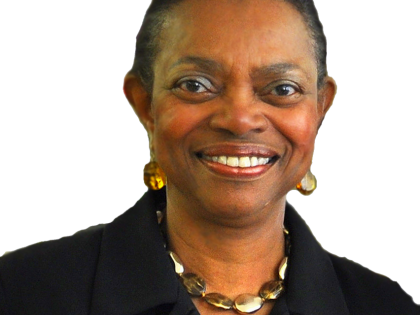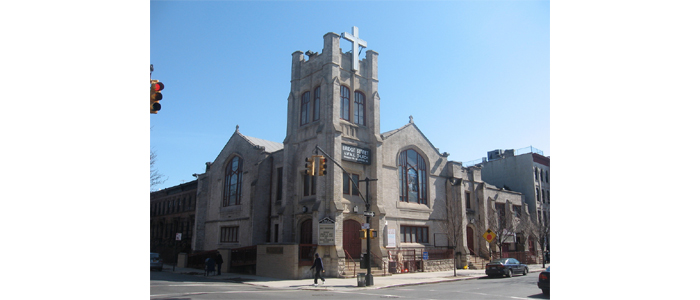
BRIDGE STREET AME CELEBRATES 250 BLESSED YEARS
Senator Velmanette Montgomery
February 28, 2016

My Friends,
It is with the greatest happiness that I introduced a Resolution honoring Bridge Street AME Church on the occassion of their 250th Anniversary.
A 250th Anniversary is an historic accomplishment, and this is only the latest in a truly historic church. It is the oldest church in Brooklyn, or anywhere on Long Island and has been a haven to all who needed its refuge or the fire of its members. I am attaching the body of the resolution a bit further down the page. I am very proud and we are all very blessed to have Bridge Street here for us.
Senator Velmanette Montgomery

Senate Resolution No. 3189
BY: Senator MONTGOMERY
COMMEMORATING the 250th Anniversary of the Bridge Street African Wesleyan Methodist Episcopal Church of Brooklyn, New York
WHEREAS, Religious institutions, and the many spiritual, social and educational benefits they confer, play a vital role in the development of the moral fabric of a responsible citizenry; and
WHEREAS, It is the tradition of this Legislative Body to pay tribute to those enduring places of worship within the State of New York whose spiritual mission and longevity have formed a bedrock of faith and inspiration for generations of their communities; and
WHEREAS, Attendant to such concern, and in full accord with its long-standing traditions, this Legislative Body is justly proud to commemorate the 250th Anniversary of the Bridge Street African Wesleyan Methodist Episcopal Church of Brooklyn, New York, celebrated on Sunday, February 28, 2016; and
WHEREAS, The African Wesleyan Methodist Episcopal Church, also known as Bridge Street AWME Church, is the oldest continuing black congregation in the Brooklyn/Long Island area; located in the heart of Bedford-Stuyvesant, this abiding congregation has stood fast through nearly three centuries of tremendous cultural, social and political change, always staying true to its missionary origins and its commitment to equality for African Americans; and
WHEREAS, Organized in 1766 and incorporated in 1818, the African Wesleyan Methodist Episcopal Church began with open-air services in downtown Brooklyn led by British Captain Thomas Webb; and
WHEREAS, In 1794 the mixed congregation of Caucasians, free Negroes and ex-slaves purchased land from wealthy landowner Joshua Sands and built a small church which was named the Sand Street Wesleyan Methodist-Episcopal Church; by 1810 the congregation had swelled to 1500 worshippers, resulting in the construction of a larger new church, the First Methodist Episcopal Church of Brooklyn; and
WHEREAS, Between 1810 and 1817, black membership had increased so rapidly in the church that relations between white and black worshippers deteriorated; when white church officials charged people of African descent a fee to worship in the galleries, the black parishioners withdrew from the church, held religious services in their homes and made plans to build a church of their own; and
WHEREAS, Fueled with determination, vision and a fierce desire for independence, the male church founders chose trustees and sent a delegation to Philadelphia to meet with Richard Allen, founder of the African Methodist Episcopal Church (AME), to seek recognition in the African Methodist Episcopal Church body and a minister for the new congregation; and
WHEREAS, The first African Wesleyan Methodist Episcopal Church (AWME) was incorporated in the Village of Brooklyn, State of New York, on February 7, 1818; the new congregation raised enough money by 1819 to purchase land on High Street and build its first church; in 1827, the men of the African Wesleyan Methodist Episcopal Church augmented its spiritual purpose with an educational endeavor, setting up an educational system for black children, and laying the cornerstone of The African Free School, known as Colored School No. 1; and
WHEREAS, This extraordinary congregation changed its name to Bridge Street African Wesleyan Methodist Episcopal Church in 1854 when it moved to 309 Bridge Street in Brooklyn; in that location, Bridge Street AWME Church continued its exalted work and played its part in historical events, including hosting Harriet Tubman and her Underground Railroad; the congregation worshipped in that location until 1938, when it purchased its present home at 277 Stuyvesant Avenue; and
WHEREAS, The venerable pulpit of the African Wesleyan Methodist Episcopal Church -- from Sand Street to High Street to Bridge Street to Stuyvesant Avenue -- has played host to some of the greatest preachers and orators of the last 200+ years, who have all championed the right of African Americans to exist as children of God and equal to all others; and
WHEREAS, Each year during the month of February, the African Wesleyan Methodist Episcopal Church pauses to celebrate its missionary origins; to offer thanks and praise for its rich and storied life; and, in honor of its founders, pay tribute to the members of the church and community who have made significant contributions to this unique black congregation in the Borough of Brooklyn, State of New York; and
WHEREAS, It is the custom of this Legislative Body to take note of enduring religious institutions and to bring such institutions to the attention of the people of this Empire State; now, therefore, be it
RESOLVED, That this Legislative Body pause in its deliberations to commemorate the 250th Anniversary of the Bridge Street African Wesleyan Methodist Episcopal Church of Brooklyn, New York, fully confident that this commemoration reflects the belief in those values which enhance the dignity and purpose of life; and be it further
RESOLVED, That a copy of this Resolution, suitably engrossed, be transmitted to the Bridge Street African Wesleyan Methodist Episcopal Church.
Share this Article or Press Release
Newsroom
Go to NewsroomFall 2019 Newsletter
December 16, 2019
GOVERNOR CUOMO SIGNS IMPORTANT CREDIT UNION BANKING DEVELOPMENT BILL
December 13, 2019